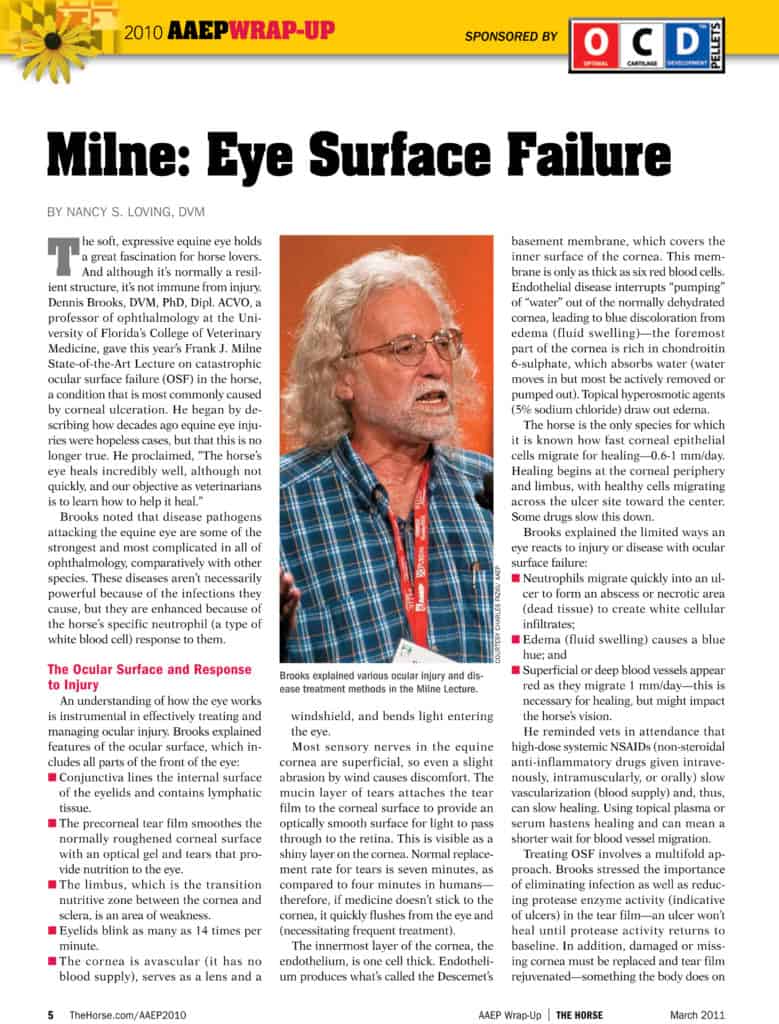


Many advances in horse reproduction were discussed during the 2010 American Association of Equine Practitioners convention, including oocyte (egg) harvesting postmortem and in live mares, in vitro fertilization, cloning, genetic testing of biopsied embryos, embryo freezing, epigenetics, stallion/mare fertility and management, stallionlike behavior in mares, twinning, and sex determination.

The soft, expressive equine eye holds a great fascination for horse lovers. And although it’s normally a resilient structure, it’s not immune from injury. Dr. Dennis Brooks gave the 2008 AAEP Convention’s Frank J. Milne State-of-the-Art Lecture on catastrophic ocular surface failure (OSF) in the horse.

A wrap-up of the 2010 AAEP Convention, including in-depth coverage of nearly 100 presentations and sessions on all aspects of equine veterinary medicine, from the top studies in 2010 to unwanted horses, lameness, equine welfare, hoof care and more.
Lameness caused by quarter cracks is a nemesis of horses and owners, and treatment is often complex.
Veterinarians can reduce a horse’s severe forelimb pain by administering a continuous, low-dose infusion of the local anesthetic bupivacaine, but this method is not suitable for every case, according to researchers from Cornell University’s College
Colicky horses that undergo exploratory surgery and are ultimately diagnosed with an ileal impaction appear to benefit from a single injection of carboxymethylcellulose (CMC) into the ileum to resolve the problem, according to veterinarians from
When horses have hemorrhaged or have experienced fluid losses from dehydration, they can end up in a dangerous state of low blood volume, called hypovolemia.
A resurgence of interest in the equine temporomandibular joint (TMJ) (which allows for opening and closing of a horse’s mouth) has led to discussions on the relationship of TMJ disease to weight loss or behavioral changes in horses.
Veterinarians commonly treat many equine infections with antimicrobial drugs to achieve resolution. However, in some cases, the antimicrobials themselves induce gastrointestinal disturbances with subsequent diarrhea. “This unfortunate side effect of
The soil-borne bacterium Corynebacterium pseudotuberculosis can infect horses and cause a condition commonly known as pigeon fever, in which the infected horses often have pectoral swelling, resembling a pigeon’s breast. Other clinical signs include
The non-steroidal anti-inflammatory drug (NSAID) firocoxib had fewer side effects than phenylbutazone in horses after 42 days of treatment, according to scientists from Merial Limited who presented comparative research results at the 2010 Convention
One of the American Association of Equine Practitioners’ (AAEP) ongoing goals is to address the welfare issues that many horses and their owners face. During a presentation at the 2010 AAEP Convention, held Dec. 4-8 in Baltimore, Midge Leitch, VMD,

Equine osteoarthritis is expensive to manage, with estimated annual costs as high as $10,000-15,000 per horse to diagnose, treat, and medicate, researchers found in one study.
Embryonic stem cells (ESCs, cells derived from embryos or generated using genetic means) have improved growth potential and are pluripotent, meaning they can form any tissue type to produce optimal healing. Unlike stem cells derived from an adult
If a veterinarian suspects heart disease in a horse, running a cardiac troponin I (cTnI) blood test can expedite a diagnosis, according to a team of Cornell University veterinary researchers. Cardiac troponin I is an excellent marker for injury to
Stay on top of the most recent Horse Health news with
"*" indicates required fields